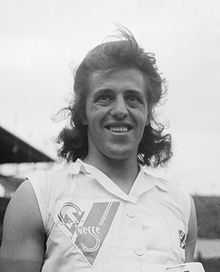Foekje Dillema
 Foekje Dillema in 1949 | |
| Personal information | |
|---|---|
| Born |
26 September 1926 Burum, Netherlands |
| Died |
5 December 2007 (aged 81) Kollum, Netherlands |
| Sport | |
| Country | Netherlands |
| Sport | Women's athletics |
| Retired | 13 July 1950 |
Foekje Dillema (18 September 1926 – 5 December 2007) was a Dutch track and field athlete.
Biography
Dillema was named "athlete of the match" in 1949 after winning the 100 metres and 200 metres race during a tournament in London. She was an important rival for another Dutch athlete Fanny Blankers-Koen, who won four gold medals during the 1948 Summer Olympics and who was voted "Female Athlete of the Century" by the IAAF in 1999.
In 1950 Dillema was banned from competition for life by the IAAF. Dillema had refused to go to a mandatory sex test for the European championships in Brussels in August 1950. Her national record of 24.1 seconds for the 200 metres was erased,[1] On 13 July 1950, Dillema was stopped on her way to an international meeting in France by the Dutch athletics authorities and expelled for life from competition. She returned home to Friesland and did not leave her house for at least one year. She lived a quiet life in her home town afterwards and always refused to speak on the subject.[2]
Dillema was considered female at birth, raised as a girl and lived her life as a woman. Her brothers and sisters never expected her not to be a woman having seen her so many times in the bathtub (her phenotype was female).
After her death a forensic test on body cells obtained from her clothing found that there was a Y-chromosome in her DNA. She might have been a genetic mosaic, having cells with either 46,XX (female) or 46,XY (male) chromosomes, in approximately a one-to-one ratio, in her skin. The forensic report speculated that Foekje developed from a zygote with an XXY genotype that promptly divided into a half XX, half XY embryo through nondisjunction. Dillema was probably an 46XX/46XY woman also known as ovotesticular DSD or true hermaphroditism.[3]
Her biographer Max Dohle concludes that Foekje, having a Y-chromosome, would never have been allowed to race in the last 45 years. The Barr body test (1966) as well as the test based on PCR (1992) scan for a Y-chromosome or an SRY-gene on the Y-chromosome. All female athletes with a Y-chromosome were expelled from competition from 1966 until 2011. At the end of the century, renowned institutions worldwide protested against the viewpoint of the International Olympic Committee, causing the mandatory gender test based on the Y chromosome to be abandoned. In case of doubt an athlete with a Hyperandrogenic Syndromes can still be tested, by a multidisciplinary medical team, during a large tournament like The Olympic Games. The IAAF and the IOC test on testosterone levels since May 2011. An athlete with hyperandrogenism not having CAIS will not be allowed to compete without a suitable medical treatment.[4]
Dohle concludes that Dillema was an intersex individual suffering from ovotesticular DSD. She had an operation on her glands in 1952. During the operation testes or ovotestes were removed. The SRY-gene on the Y is the testis determining factor, so Foekje may have had infertile testes or ovotestes palpable in her groins. These (ovo)testes produce more testosterone than ovaries. Higher testosterone levels are considered as unfair towards the competition. This standpoint is still widely discussed.
See also
References
- ↑ Farndale, Nigel (25 October 2009). "Athletics: Caster Semenya the latest female athlete suspected of being biological male". The Daily Telegraph. Retrieved 13 December 2009.
- ↑ Dohle, M. (2008) Het verwoeste leven van Foekje Dillema: de grootste tragedie uit de Nederlandse sportgeschiedenis, Arbeiderspers, ISBN 978-90-295-6687-2
- ↑ Andere Tijden Sport – Het mysterie Foekje Dillema. NOS Dutch broadcast 2008
- ↑ Karkazis, K.; Jordan-Young, R.; Davis, G.; Camporesi, S. (2012). "Out of Bounds? A Critique of the New Policies on Hyperandrogenism in Elite Female Athletes". The American Journal of Bioethics 12 (7): 3–16. doi:10.1080/15265161.2012.680533. PMID 22694023.
Bibliography
- Katrina Karkazis, Rebecca Jordan-Young, Georgiann Davis and Silvia Caporesi. Out of Bounds? A Critique of the New Policies on Hyperandrogenism in Elite Female Athletes. The American Journal of Bioethics, 12(7): 3–16, 2012
- Dohle, M. (2008) Het verwoeste leven van Foekje Dillema: de grootste tragedie uit de Nederlandse sportgeschiedenis, Arbeiderspers, ISBN 978-90-295-6687-2
- Andere Tijden Sport – Het mysterie Foekje Dillema. NOS Dutch broadcast 2008
External links
| Wikimedia Commons has media related to Foekje Dillema. |
|